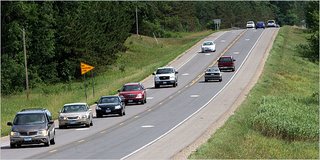All the problems in the world are now solved! ....Click here for LINK

From the NY Times:
BUFFALO, Minn. — Even after a collision five years ago resulted in surgery and left her with limited mobility in her neck, Missy Weberg said she continued the dangerous habit that caused the accident: tailgating.
But a new Minnesota initiative using big white dots painted on a state highway is helping Ms. Weberg back away from cars in front of her, she said.
The dots, 94 of them painted on a two-mile stretch of a rural highway about 35 miles northwest of Minneapolis, were unveiled last month in a pilot project that officials hope will teach drivers about safe following distances.
“If they had more dots, I’d probably tailgate a lot less,” Ms. Weberg, 36, said. “I’m guessing it will save a lot of accidents and lives.”
Maryland started a similar project this month on the eastbound span of the Chesapeake Bay Bridge in Annapolis using hot pink panels. Pennsylvania began experimenting with distance dots in 2000, but stopped adding them to roads in 2003 because transportation officials said they were not deterring the worst offenders.
Although many drivers might see tailgating as nothing more than an annoyance, it is a significant factor in many accidents, safety officials said. In Minnesota, rear-end collisions accounted for 28 percent of all crashes last year and resulted in 22 deaths, according to the State Office of Traffic Safety. And the number of rear-end crashes in the state increased to 24,820 last year, from 22,206 in 2002.
“It’s truly dangerous,” said Pat Hackman, executive director of Safe Communities of Wright County, a nonprofit traffic safety organization. “And some people might say, ‘Don’t we have bigger problems than this?’ And we certainly do. But I don’t think you quite understand how this is contributing to the bigger problems that we have.”
The idea of the dots on the highway here, explained on roadside signs, is for drivers to keep a distance of two dots between vehicles. The 225 feet between dots represents a driving interval of three seconds at the speed limit of 55 miles per hour.
Gordy Pehrson, traffic safety coordinator in the Office of Traffic Safety, said he hoped the dots would have a “halo effect,” with drivers taking the lesson to other roads as well.
“This is not intended to be the cure-all for all the tailgating problems,” Mr. Pehrson said. “Obviously we’re not going to paint dots on every road in the state.”
Some area residents said they thought that few drivers would pay attention to the dots without more police enforcement and complained that the $25,000 federal grant to start the program was a waste of money.
Luke Zumbusch, 18, of Buffalo, said he thought some drivers would ignore the dots. Mr. Zumbusch said he would continue trailing as close as a half car length behind slow drivers to try to push them to go faster.
“I think they mean good by it,” he said of transportation officials, “but it’s just going to be pointless.”
State officials chose the stretch of road here that cuts through farms and rolling fields because it has an accident rate that is higher than average. Almost 80 percent of crashes at intersections on the highway are rear-end collisions, officials said.
They recorded speed and following distances before the project began and will continue to do so in its three-month run to measure the effect of the dots, which make the black paved road resemble a long domino.
Mr. Pehrson said state officials were encouraged by the early success in Pennsylvania. The Pennsylvania project won a National Highway Safety Award in 2001 after a study found that tailgating dropped 60 percent on one dotted stretch of highway.
But a Pennsylvania Department of Transportation spokesman, Rich Kirkpatrick, said the state discontinued the program after a longer-term study showed that although safe drivers increased their following distance, the dots had little effect on aggressive drivers.
“They seemed to just ignore the dots and the safety signs ,” Mr. Kirkpatrick said.
Some drivers here, though, remain enthusiastic about the Minnesota experiment. Matt Graunke, 28, of Buffalo, said people might not realize the difference the dots were making.
“I find myself, when I’m on that section of road, counting them whether I like it or not,” Mr. Graunke said. “If it’s going to keep one person from getting killed, it sounds fine to me.”
Riding in the car has become a lot more fun for Lauren Stenlund’s 4-year-old daughter, Taylor, who loves counting the dots and catching her mother when she is not keeping a proper distance.
“We try to turn it into a game,” said Ms. Stenlund, 25, of Greenfield. “It’s kind of fun for kids because they can tell you if you’re doing it right or wrong.”
And as for Ms. Weberg, who had trouble changing her habits, the dots are a reminder to stay vigilant.
“I’m just an impatient driver,” she said.
